
Tea Production
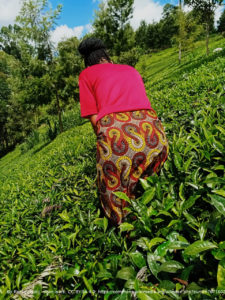
Welcome to Tea Production: The Energy Efficiency Podcast – episode 20, the podcast that brings you a mix of energy efficiency news, products and tips all year round. We’re interested in profiling people and products involved in promoting energy efficiency habits, products and information, so please do get in touch if you have something to contribute.
Silent Power
This week: energy efficiency in tea production, food recycling, and the Air Quality Grant Scheme. But first, last week Business Live reported on a revolutionary power restoration project in the north east of England. Known as Silent Power, the two year trial will deliver power via electric vans with on-board energy storage systems.
Three companies are working together to deliver this project, designed to help the most vulnerable customers in the event of planned maintenance or a power cut. Northern Powergrid runs the electricity distribution network in the north east, Yorkshire and northern Lincolnshire. It’s working on this project with Sunderland energy storage company Hyperdrive Innovation and Rugby-based OffGrid Energy.
Replacing diesel generators
When power has to go off for works, or there’s a power cut, usually a noisy, smelly diesel generator leaps into action to supply power. Northern Powergrid alone uses over 2,500 diesel generators every year. Silent Power instead supplies clean and quiet replacement energy for up to three homes or one small village hall per van, for up to 24 hours. The scheme is aimed at the most vulnerable customers, identified by the power companies and reached as a priority in the event of a power out, and those with domestic solar generation. Homes that put power back into the grid, which is most domestic solar installations, can’t use diesel-generated power.
The three companies behind the trial, which starts this month, see it as a shift in the temporary power industry. It removes issues of getting diesel generators to places that are awkward to access, and removes the issues of noise and air pollution. Northern Powergrid can reach more of their customers with these vans. The vans’ lithium ion batteries run silently and produce a reliable power stream, unlike generators which do sometimes trip out.
Northern Powergrid sees wide application of the new technology beyond simply supplying temporary energy to homes. It can be deployed across many sectors to reduce reliance on fossil fuels and continue to bring down emissions. During the trial the project will be assessed for usability, economic viability and benefit to customers. The findings will be shared with other Distribution Network Operators.
Energy efficiency in tea production
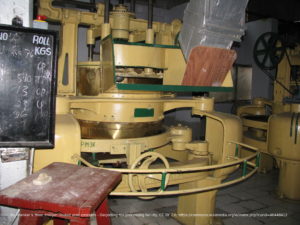
Getting tea from the plant to your cup is inherently polluting at the moment. Emissions are generated as leaves are processed, which involves withering, rolling, fermentation, drying, sorting and packing, transportation and packaging. The energy-intensity of each process impacts the profitability of the tea business and the lives of the employees, but there is much that can be done to reduce the environmental impact of the other processes, including the way of life of the tea farmers.
Taylors of Harrogate, which produces both tea and coffee, has examined its carbon footprint and is making changes. Its factory in Harrogate now runs on renewable energy, coming in part from solar panels on the roof, and it sends zero waste to landfill. Road miles from port to factory have been reduced by the simple measure of bringing their products in to a nearer port. It’s working with overseas suppliers to help them reduce their carbon footprint too.
Tree planting
Taylors is conscious though that these measures will reduce emissions but not remove them completely. To address this, it’s working with projects in Uganda, Kenya and Malawi to plant trees in some places and reduce the number being felled for fuel in others. 4000 smallholder tea farmers around Mount Kenya are being supported to plant a million new trees, in conjunction with The International Small Group Tree Planting Program, known as TIST. TIST was started in 2002 and works in Kenya, Tanzania, Uganda and India. TIST’s aim is “to empower and equip subsistence farmers to restore their natural environment, increase soil fertility, create jobs, strengthen the local community, and move from famine to surplus.” This last aim is achieved in part by planting trees that provide a crop that can be sold, eg avocados and mangos.
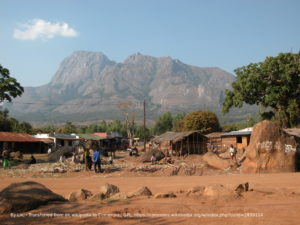
In Malawi firewood is commonly used for cooking by the tea farmers. Taylors is working with the Ethical Tea Partnership, United Purpose and other (unnamed) tea companies to provide much more efficient cooking stoves. They use much less wood which reduces the deforestation which has become a major issue around Mount Mulanje in Malawi. Reduced smoke from these stoves is good news for the women who usually do the cooking, and this is something that came up last week when we looked at the Three Per Cent Club. The carbon reductions achieved by Taylors and partner organisations are independently verified.
In Kenya progress is being made in several areas. Eastern Produce runs agricultural interests in Kenya, Malawi and South Africa, as part of Camellia Plc (Camellia sinensis is the latin name of a common tea plant). It employs 73,000 people so its actions will be influential in its sector. On its website it describes social and environmental welfare as “paramount to the sustainable future of our operations”. Undoubtedly social issues have been difficult to manage on tea plantations worldwide and solving acute problems such as abuse, child labour and poor employment conditions take precedence, but addressing environmental concerns will also affect the quality of life of the people working on the plantations.
Sustainable employment
Eastern Produce wants to provide sustainable and ethical employment to its tea producing communities for years to come through careful custodial management of its operations. It’s very awake to the business benefits of long-term investment and taking good care of its employees.
Eastern Produce monitors the environmental impact of its activities and ensures they comply with legislation. It seeks to minimise the environmental impact of those areas of its operations that could use improvement. For example, in one Kenyan factory waste water from tea production is filtered through a series of ponds (you might recall from our feature on distilling that a number of distilleries use the same sort of system). The ponds are planted with species that absorb nutrients and clean the water before it’s released back to the natural water courses locally.
Energy reduction
In its Chief Executive’s report of April this year, Camellia Plc sets out its energy usage for 2016, 17 and 18. Energy use and carbon emissions have fallen steadily over the three years, something the report attributes to investment in energy efficiency in its tea factories. It’s achieved a reduction of 6.4% in the energy required to process each kilo of tea. In the same period use of renewable energy leapt by 57%. Interestingly Camellia identifies modernising as one element of improving energy efficiency, reflecting the fact that old machinery is often very energy intensive to run. Replacing it is worth the investment. Additionally Camellia is switching to sustainable and renewable fuels, and changing its agricultural practices to be less demanding of water, fertiliser and other resources.

Also in Kenya, a solar park has been commissioned that will supply power to Unilever Tea Kenya’s tea-leaf processing plant in Kericho County in the Rift Valley. The mini grid has been built within the factory complex. The solar panels are on rotating solar trackers, which boosts output by up to 20%.
Investment
The project has been financed by CrossBoundary Energy, an investment firm specialising in off-grid projects for business in Africa. In turn, CrossBoundary Energy has received a $6m dollar contribution from the Overseas Private Investment Corporation (OPIC), the American government’s development finance institution. This investment will be divided between six solar projects in Africa.
The mini-grid will product 619 kWp, which is enough to process all the tea leaves harvested from the Kericho plantations. Producing power on-site reduces Unilever’s exposure to power price volatility through a power purchase agreement with CrossBoundary Energy, while reducing its use of natural resources. This is part of the company’s ambition to have all its food plants running entirely on green energy and the business model is of great interest to other companies and sectors. Developing business in Africa will rely on the easy supply of clean energy. OPIC’s investment in CrossBoundary Energy helps to expand PV technology across sub-Saharan Africa.
Iran

If you were asked to name tea producing countries you’d easily come up with India and Africa, and probably China, but did you know that Iran produces a tea crop? 70,000 tea-growing families deliver picked leaves to 160 processing factories in Guilan province and Mazandaran Province in northern Iran. Reducing the energy taken to produce the tea increases profitability for farmers and factory owners. Research carried out three years ago looked at opportunities for improving energy efficiency in Guilan province.
Training
One early finding was that no tea factory manager has ever received energy efficiency training and didn’t know such courses existed. Part of the research focussed on whether the managers could identify which parts of the tea-producing process was the most energy intensive. Most correctly identified the tea drying stage, and recognised that saving fuel here would lead to financial savings. That in turn identified that good design and the correct operation of drying furnaces is key to energy saving.
The research shone a spotlight on some misconceptions about how machines can be used and revealed that poor maintenance leads to needless heat loss. Better timing of the various steps in tea leaf production can improve energy efficiency. If leaves are too damp or not damp enough they need different treatment, which uses more energy than necessary. None of the tea factory managers had any technical training in tea production, instead learning on the job. This of course perpetuates habits and does little to introduce new ideas.
The managers who took part in this research agreed that better technical knowledge and training was vital to improving energy efficiency. They welcomed investment in more energy efficient plant, and closer links with other areas of industry so that they can benefit from technical advancements. The Iranian government can supply factory owners with long-term low-interest loans, but awareness of this was low. Ultimately, poor energy efficiency was attributed to poor management and outdated knowledge, both of which are pretty straightforward and economical to rectify. Iran can learn from the experiences of China, India and Kenya, but it needs to be motivated to improve energy efficiency. The report suggests a system of subsidy and bonus to achieve this.
Air Quality Grant Scheme
Obviously it’s about improving air quality, but how does it do that?
It’s a pot of money that local authorities bid for.
For transport projects?
It could be, but its primary point is to help local authorities meet their statutory duties under the 1995 Environment Act.
Is it a new scheme?
No, it’s been going over 20 years! It started in 1997, and since then it’s dished out over £60m. It works on a financial year basis, so we’re currently in the 2019-2020 programme. By the way, if you want to apply you have until 7th November, not long.
Is there a theme or priority each year?
There certainly is this year. Defra is behind the scheme, and this year it’s looking to finance work that provides swift improvements in air quality-
-what counts as swift?
In this instance 1-2 years. It’s also looking at projects that have long term benefits by “increasing awareness and encouraging behaviour change”, so in other words putting the onus back on individuals while more roads are built and Heathrow gets another runway!
How much is on offer this year?
At least £2m, available to English local authorities and within that those areas that are likely to exceed emissions limits, and places with designated Air Quality Management Areas. If a local authority identifies an area that won’t stay within emissions targets, it has to declare it an Air Quality Management Area. It could be a couple of streets or an entire town centre.
Presumably the local authority then has to come up with a plan to solve the problem?
Yes, known as a Local Air Quality Action Plan. Herefordshire has two air quality management areas, one in the north of Hereford city, and one at the Bargates traffic lights in Leominster. Bargates routinely fails to stay within emissions targets.
How have previous awards been spent?
28 awards were made in 2018-19, from £33,000 to £450,000. Some was spent on the obvious things such as campaigns to raise awareness of polluting behaviours and developing environmentally-friendly habits, but there have been some innovative projects. In Islington electric charging points have been installed for canal boats. Money has also been spent on building green walls, funding car-free days and developing pedestrianisation schemes. In Portsmouth money went towards cycling infrastrcture, and in Westminster it funded work with businesses to reduce emissions. Something that caught my eye was an anti-engine idling campaign. You see less of it now than you did. I hope it’s one of those things that will become socially unacceptable.
Those projects are very varied. Do they make any real difference?
That depends who you ask. Defra says harmful fine particulate matter (PM2.5) levels have dropped by 10% and nitrogen oxides by 29% between 2010 and 2017 and that levels of nitrogen dioxide at the roadside are at their lowest levels since records began. Friends of the Earth says the funding is a drop in the ocean. Their focus is on clean air zones.
What does that involve?
Strict rules on vehicle emissions and requirements. There are five already: Birmingham, Leeds, Nottingham, Derby and Southampton. More areas are under investigation as the government believes they will exceed pollution limits by 2021.
Who sees those through?
Local authorities.
There’s a hole in my bucket.
Exactly. These areas submit an Air Quality Improvement Plan, and get funding if they are approved. Green groups including Greenpeace believe these are the most effective way to bring down pollution. Client Earth, lawyers working on environmental cases and causes, view this as the government dumping the problem on local authorities. The government’s response is that local authorities know best what’s needed in their area.
But surely some of the projects must be making a difference?
Yes they are. In London nine Low Emissions Neighbourhoods have been created.
What’s different in those areas?
They aren’t all the same. In one place you might have an emphasis on infrastructure for low emissions vehicles, in another it might be paths and cycle routes so people can move around with less use of cars. There’s a social knock-on too-
– as people aren’t so shut away in cars they see each other more?
That’s right, and less busy roads are less divisive.
Where are these neighbourhoods?
They include Barbican – not just the famous flats but the area around it. The most successful features of that Low Emissions Neighbourhood or LEN are being assessed for roll-out across the rest of the City of London, the square mile. This particular LEN focussed on raising awareness, reducing traffic and supporting low and no-emissions vehicles.
How was the project monitored?
Automatic analysers were placed in the area to collect data on levels of nitrogen dioxide and particulate matter. They also used the magnificently named smogmobile. This was an electric car fitted with air quality monitoring kit. It drove around the Barbican area for three days to gain a picture of how pollution levels change during the day and over a few days. The critical environmental groups may well be right that the money is too little too late, but that doesn’t mean that the projects that spring up as a result of the Air Quality Grant Scheme aren’t in themselves worth it.
It sounds like they have the capacity to make a real difference for the people who live in the areas taking part.
That’s right. We’re always saying that decent cycle routes around here would be brilliant. If there was an off-road proper cycle route that our son could take to school and another in the opposite direction that our daughter could take to the station our car use would drop by 90%.
If you live in an area blighted by heavy traffic and as a result of one of these projects you notice a drop in traffic and less pollution that’s going to make life a bit nicer, isn’t it?
For sure. Undoubtedly it’s a complicated situation and there are many shades of opinion on it. It seems like no episode is complete without a quote from Sadiq Khan, for no very good reason, so here’s another: “politicians can’t solve these issues alone. We need government ministers to wake up and recognise the true scale of this health emergency”. And so say all of us.
Food recycling
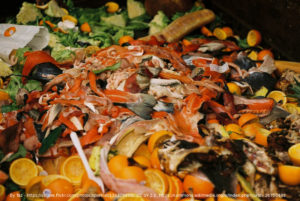
I have two contrasting tabs open in my browser: one tells me that 14% of food produced is wasted between harvest and retail, the other that UK firms have saved more than £85m worth of food going to waste. So what’s going on?
Food Waste Reduction Roadmap
Last year WRAP and IGD led the Food Waste Reduction Roadmap in September last year. You may well not have heard of IGD. It describes itself as “a research and training charity which sits at the heart of the food and consumer goods industry”. The aim of the Food Waste Reduction Roadmap is to get large companies reporting on and reducing their food waste. There are now 156 food businesses signed up, with related businesses such as industry bodies and redistribution organisations joining the scheme.
WRAP reports that 121 companies have shown evidence of food waste reduction amounting to 7%. It might not sound like much, but it equates to 53,000 tonnes of food with a value of £85m. WRAP acknowledges that there is a great deal more to do. It wants all major food businesses implementing the Roadmap, from across the spectrum of the food sector.
There is a need for initiatives such as this Roadmap because globally about 1/3 of food is wasted. Digest that for a moment, as commentators regularly wonder where the food is going to come from to feed the world’s growing population. The IPCC recently reported that food waste contributed up to 10% of man made greenhouse gases between 2010 and 2016.
 Reporting
Reporting
Tesco was one of the first companies to sign up to the Roadmap. CEO Dave Lewis wants to see food waste reporting publicly become mandatory, and WRAP and the IGD believe a consistent approach across business is key to achieving meaningful waste reductions. WRAP and the IGD package the Roadmap measures under the phrase Target, Measure, Act – so what do they really mean?
The target is the food waste reduction target for the UK operations of participating businesses. Measure is measuring their surplus and waste, and Act is taking action to reduce food waste both in their own businesses and influencing behaviour along their supply chain and among their consumers. Among participating businesses some are well along the road, already reducing waste, while others are still collecting data before they can set a target.
The businesses involved pack a punch. Together they represent 50% of the total turnover for all UK food manufacturing, hospitality and food services, at £230bn. It’s estimated that these businesses will generate over a million tonnes of food waste per year, which is one third of what WRAP’s own report terms “post-farm gate supply chain food waste”. Of that 70% was intended for human consumption.
Benefits
Businesses implementing Target, Measure, Act are seeing the benefits aside from the initial 7% savings in food waste. Businesses are sharing case studies, sector-relevant frameworks are being created, and many organisations are getting involved to help things along in their area of the food sector.
However there are at least 500 businesses that still need to engage with Target, Measure, Act if the UK is going to meet UN Sustainability Goal 12.3. This “aims to halve per capita global food waste at the retail and consumer levels and reduce food waste along production and supply chains by 2030”. Achieving this goal for the UK would mean an annual farm-to-fork food waste reduction of 3.5m tonnes in 2030, saving food valued at £10bn a year.
Courtauld Commitment 2025
Most of our big supermarket chains have been measuring their waste for several years under the Courtauld Commitment 2025. This is a WRAP-driven voluntary agreement for businesses to make food and drink production more sustainable. It’s built around a 10-year commitment to cut carbon, water and waste associated with food and drink by a minimum of 20% by 2025. The large supermarkets are often criticised for the pressure they can and do bring to bear on their suppliers financially and for rejecting the less beautiful fruit and veg, but this influence can be put to good use too to encourage energy saving and waste-reduction among their suppliers and customers.
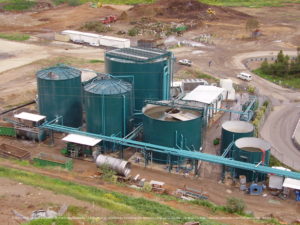
There’s a link in the notes to a list of case studies. To pick out a couple, Aldi has worked with Neighbourly to donate a million meals. Neighbourly connects shops with a surplus to organisations that can put that surplus to good use in charities and schools. Many supermarkets now work with this and similar schemes. Boots, which tends to specialise in short-life products such as sandwiches and fruit, the sort of thing you might pick up for lunch if you’re on the move, has reduced food waste by nearly 20% over the last 3-4 years. It’s pledged to reduce food waste by 50% by 2030. Frozen food chain Iceland sends no food to landfill, and is left with only 0.7% of its stock unsold. Instead unsold food is given to the community or used to make animal food and beer. Some heads to an anaerobic digester to make electricity and compost.
Why is food wasted?
Why does food go to waste in the first place? Supermarkets have a good idea of how much of any given product they’re going to sell in a day or a week, but blips occur. Closer attention to stock management has made a difference to supermarkets including ASDA and the Co-op, while some manufacturers are taking steps to increase shelf life. Food producers need to focus on maximising yield from their raw ingredients and do what they can to prevent over-production. Some food goes to waste during manufacturing through leaks and spillages, so paying attention to kit and processes makes a difference here. Many improvements can be made in farming the grains, fruit and vegetables that go into food manufacturing, so that fewer crops are discarded or not up to snuff. Farmers have made improvements in irrigation, crop protection, precision delivery of fertiliser through technology, and precise analysis of growing and harvesting patterns.

Guardians of Grub
Restaurants have been targetted by WRAP’s Guardians of Grub campaign. It’s focussed on reducing the £3bn worth of food thrown away at hospitality and food service outlets, 75% of which could have been eaten. WRAP claims that their resources are applicable to every outlet from the swankiest restaurant to your local pub.
It comes down to simple, cheap changes to the purchase, preparation and serving of food. Simple measures include the blindingly obvious such as someone actually tracking food use and waste which then informs buying; checking items are used before their expiry date; using ingredients in their entirety, from chicken bones to broccoli stalks; freezing usable excess ingredients and encouraging customers to take leftovers home with them. I thought everyone did this anyway – we certainly do. Really it’s what you do at home, but scaled up – buy only what you need and are going to use, freeze anything you don’t use, eat the leftovers and make sure things don’t go to die at the back of the fridge.
Waste needs to be defined in the context of food production. If the metric is ‘could that have been eaten?’ then yes, a great deal of food is wasted in this country. If we ask instead ‘what happens to wasted food?’ then the picture is less bleak, with only a small proportion going to landfill. Much unsold food now goes to groups that can use it feed hungry people. Unsold crops can be ploughed back into the earth, where they will support the next crop to be grown there. Some are used to feed animals or go into anaerobic digesters to create electricity or compost, which again will feed future crops. Unsold products can be diverted into processes including beer making – we saw in our feature on the VIBES awards that a bakery sold surplus rolls to a brewery for a special beer.
Despite many of the measures taken by businesses big and small being firmly rooted in common sense, businesses need support to take steps if they aren’t to feel they’re a lone voice. Among big business reducing food waste is now a badge of honour, but it’s probably harder for your local chippie or pizza delivery shop that’s having to compete with lots of other local outlets and serving a clientele that maybe doesn’t prioritise or value energy efficiency in food production. Businesses signing up to the Roadmap will find that support, plus resources to help them formulate a strategy and turn round food waste.
EVENT
On 13th and 14th November you can attend the World nZEB Forum 2019 in Ireland. The theme this year is Climate Action through nearly zero energy buildings, or nZEBs. “The event will showcase the very best in expertise, design, case study buildings and innovative products.” The website goes on to say “If you’ve not yet heard of nZEB, or you want to explore this topic in greater detail, you’ve come to the right place. We are certain you will leave this event inspired and ready to embrace what is a paradigm shift in how we design, build and operate the spaces where we live and work.” The event costs E295 for non-members and E265 for delegates from qualifying organisations.

What are we up to? Our trial cuts on the new laser cutter are very promising. We expect to have new stock by the end of October, so get in touch on info@ecoflap.co.uk if you want to reserve one. We are now unable to despatch abroad due to uncertainty around Brexit. Thank you for listening to episode 20 of the Energy Efficiency Podcast. Until next time you can find us on both Twitter and Instagram as Ecoflap, and on Twitter we also tweet as The Petflap. Next week: energy efficiency and participatory budgets, energy efficiency in freight, and the UK government’s new Environment Bill.
Music credit: “Werq” Kevin MacLeod (incompetech.com)
Licensed under Creative Commons: By Attribution 3.0 License
http://creativecommons.org/licenses/by/3.0/
